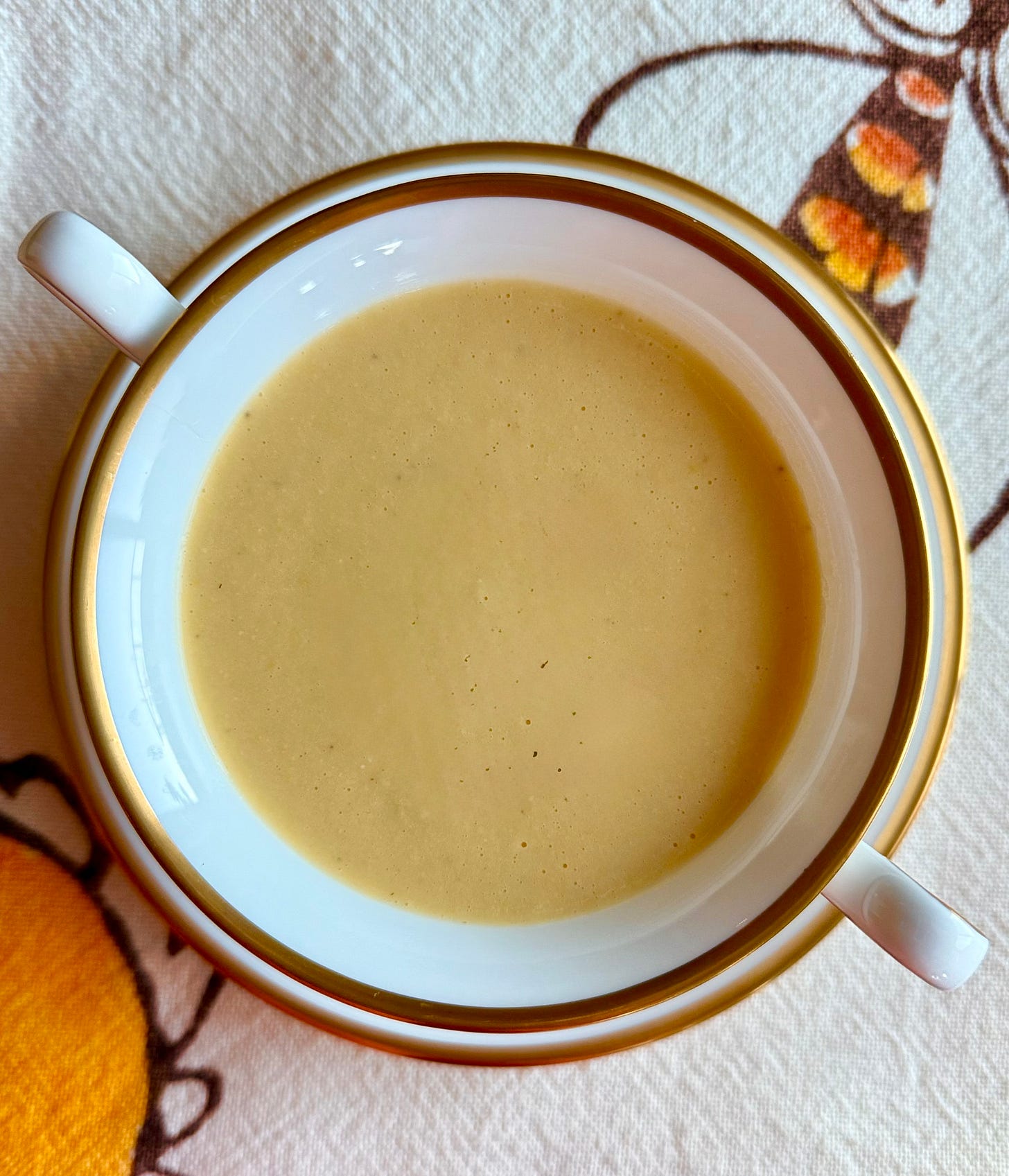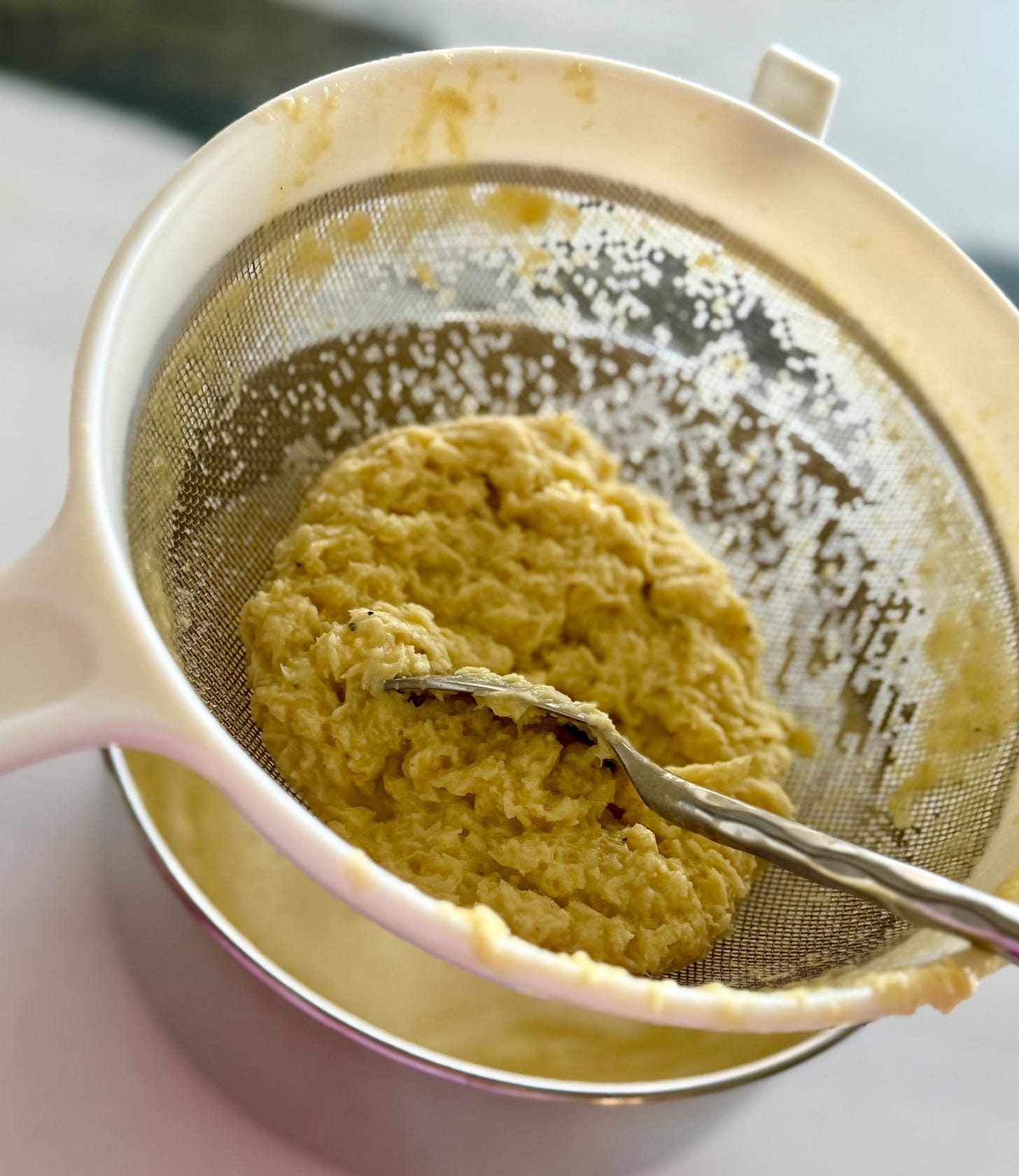A place at the table
and a recipe for silky smooth corn soup to make now and eat later
To everyone new here, welcome. I’m Elizabeth, the writer of The Delicious Bits Dispatch, a weekly missive for the curious, blending discovery, reflection, and musings, always wrapped up with a seasonal recipe worth lingering over.
When Sunday rolls around, I’m usually betwixt and between.
These days the inputs into my creativity are encountering toxic waters. Try as I might to remain positive, to stay focused on the meaningful dialogues in my head about the beauty and wonder of the world, it’s a fraught place to be a writer whose purpose is to find joy in the everyday.
Finding the balance between being blithe about a new recipe or the magic of late season corn and the hard realities of famine, war, food insecurity, and injustices in our own backyards is the toughest kind of writing to do these days.
And yet, I think the need for that type of positivity is more important than ever, with meaningful inspiration just a read—not a scroll—away.
Abundance at the table
There are many food writers I follow here on Substack, each with their own proclivites and slants. Whether the focus is baking or low-glycemic, Californian or Indian cuisine, weeknight pasta or vintage recipes1, the spirit of generosity, of sharing the abundance at the table, is prevalent throughout.
For these writers and many others, including me, there’s also a deep recognition that there is an exterior world beyond the soothing pages that fly in the face of the comfort food we offer. A world where food decisions are not choices but pragmatic, binary realities—to have or have not.
Taking stock
One such writer that I read eagerly every week is Naomi Duguid, who writes Home & Elsewhere. Self-described as a home cook that’s “curious about food and agricultural traditions in the wider world; striving to keep my beginner’s mind open,” Duguid is an accomplished cookbook author that doesn’t just offer recipes but seeks to understand how people live, how local environments shape food, and how traditions evolve.
In her latest musings, Duguid offers food as a way to stay centred in this era of uncertainty and unhinged untruths. “We need our sanity, we need to stay grounded. Appreciating our ingredients and what we can do with them in the kitchen is a great way to do that.”
The challenge is that food doesn’t just ground us; it can also weigh us down, both figuratively and literally. The simple act of eating has become tangled up in a reflection of our discipline and virtue. A slice of cake is “sinfully good,” a salad “wholesome.” Far from being descriptive or even neutral, these words reveal how food has been moralized, how choices in the kitchen may be interpreted as choices about the kind of people we are, a quandary that Duguid also explores:
No wonder many people, especially women, feel anxious about making food choices. Many of them are pinched economically. They try to do the “right thing”: to choose foods that are, for example, good for the environment and for the health of their family. We judge ourselves (and others) about our food choices and eating habits, our food performance. We do it automatically, and mostly subconsciously I think.
Naomi Duguid, Food Anchors in Stressful Times
Moralizing food choices casts certain meals as virtuous and others as failures, yet so often what we eat is shaped less by willpower than by circumstance—by access, time, culture, and cost. To see this clearly is to loosen the grip of judgment: food is not a test of character but a part of life, and when we release the moral weight from our plates, we make more space for joy, connection, and care at the table.
Life during wartime
There is one more writer I’d like you to know:
. As she describes her work:Imaginary Recipes: Stories from War & Peace began as a memoir about food and cooking during the siege of Sarajevo, Bosnia & Herzegovina (April 5, 1992-February 26,1996), where I lived at the time.
Talking about food became a way to explain war and how it affects civilians.
What does it mean not to know where the next meal is coming from? Or when?
I wanted to honour the resilience of people living under impossible circumstances and their ability to invent something from nothing. Wartime meals are more than survival. They are acts of resistance and hope.
Amela writes with such grace and beauty…an inimitable blend of humour, storytelling, heartache, reflection, history lessons, and the tiny moments in life that pierce us with joy. All of it radiating from food. Start here and meet Amela, and then go to her first post and read them one by one—as engrossing as devouring a beautiful novella.
And so we cook.
The distant shores may still spray up dark waters, stormy nights, the crackle of thunder that comes ever-closer. Still, we cook.
In the act of offering sustenance where and how we’re able, there is a constant kindling of the care we must take, the attention to be paid to what happens beyond our kitchen walls.
If you enjoyed this, let me know by clicking the ❤️ button. It helps spread the word about Delicious Bits and brings me joy. Thank you, dear readers and eaters!
Smooth as silk corn soup
adapted from Melissa Kelly
serves 6
When it’s nearly October, I go to the market with bated breath, hoping that the last of the season’s corn can still be found. Cast in the form of high-fructose corn syrup, cattle feed, and ultra-processed foods, corn is often condemned; yet as sacred sustenance and a harbinger of harvest, it is also glorified. Corn can be both hero and villain in the story of food morality.
I present it here in its simplest form: a soup that nourishes and fills, that warms and gives comfort, that plays well with others. Serve it with grilled shrimp for an elevated play on shrimp with grits. Finish it with an improvized garnish of tiny seasonal vegetables cut in minute pieces and quickly sauteed. Make extra and freeze it: the sunny yellow bowls will bring you great joy in the depths of winter’s despair.
Note: Straining the soup as you blend may seem like a cheffy, fussy step, but the fibres you remove will make this especially smooth.
Ingredients
1 teaspoon extra-virgin olive oil
1 medium onion, diced
3 cups cauliflower florets (about ½ medium head)
4 ears fresh corn, kernels removed
1 teaspoon minced garlic
1 bay leaf
2 cups vegetable stock, plus 1 cups water
½ cup heavy cream
1½ teaspoons salt and a few grinds of freshly ground pepper (more to taste)
Heat olive oil in a saucepan over medium heat. Add onion and cook for 5 minutes or until translucent.
Add garlic, bay leaf, cauliflower, and corn. Cook for 10 monutes, stirring occasionally.
Add vegetable stock and water and bring to a boil, then reduce heat and simmer for 15 minutes until the cauliflower is very tender.
Stir in cream, return to a boil and then turn off heat. Season with salt and pepper Remove bay leaf and cool for at least 10 minutes
Puree the soup in batches in a blender, straining each batch as you go for a super smooth and silky consistency (see Note). Serve warm as a full portion or as little appetizer-sized sippers. This soup freezes beautifully.
A very partial list of some Substackers you might enjoy:
; ; ; ; ; —with many more to explore.



A great piece, Elizabeth. It does feel very hard to find that balance. And I also agree on the judgment issue you bring up.
Melissa Kelly of Primo is one of my favorite potager garden chefs. Food is a territory we should not let moral weights encroach on- it’s our job to find inspiration and foodstuffs that don’t require rarity and dollars- that gives everyone opportunity to make their choices of how to invest. Great post!